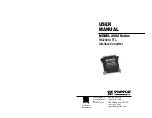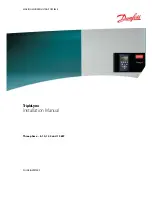
14 -en
installation and configuRation manual
foR auRoRa photoVoltaic inVeRteRs
7. confi guration dip-switch for input channel operation mode.
The RS485 communication port is the inverter’s communication port. AURORA uses a HALF-DUPLEX RS485 communication line
made up of two transmission reception lines (+T/R and –T/R) and a reference communication line (RTN): all three lines must be
wired in a daisy-chain (“in-out”). It is advisable to use a twisted-pair screened cable for the communication line: the screen must
be earthed at only one point (typically near the monitoring system) and continuity inside each element of the chain must be
given to the screen. Refer to Appendix B.
The chain connection can be made without distinction by using the connector couples (one for in and one for out – det. [p]) or
the terminal block (det. [Q] or det. [R]). The connectors are identifi ed by the printing “RS485(A)” and “RS485(B)”: use of connector
“A” as in and “B” as out is not compulsory (both connectors can be used as in or out). Refer to APPENDIX A for the PIN-OUT of
the RJ12 and RJ45 connectors.
The last inverter in the daisy chain must be “terminated” or the 120 Ohm communication line termination resistance must be
activated by switching the dip-switch (det. [s]).
The PVI-3.0/3.6/4.2/10.0/12.5-TL-OUTD models are equipped with a two-level terminal block allowing one level to be used for
line-in connection and the other for line-out connection. The terminal block is also equipped with the LNK terminal for the
PVI-3.0/3.6/4.2-TL-OUTD models and SCLD for the PVI-10.0/12.5-TL-OUTD models allowing continuity to be given to the cable
screen.
On the other hand the PVI-5000/6000-TL-OUTD models are equipped with a one-way terminal block (det. [Q]) and therefore it
is necessary to couple the line-in and line-out leads in the same clamp.
note about the built-in usB port in the pVi-3.0/3.6/4.2/5000/6000-tl-outd models
The USB communication port is a service port. This port exists for diagnostic use and the internal controller’s fi rmware upgrade and is
limited to service staff. Although drivers have been released (compatible with Windows XP and for which no upgrades are envisaged)
which permit this port to be also used for monitoring (not recommended), the primary use remains strictly tied to debugging and
updating the system. Power-One recommends the use of the RS485 port for the continuous monitoring of system data.
With regard to the communication interface, the use of the dedicated Power-One PVI-RS485_RS232 or PVI-USB-RS485_232
type converter is strongly recommended in order to prevent compatibility problems that can sometimes be encountered with
the standard models on the market.
RJ12 connectors,
terminal block and termination
resistance for the pVi-3.0/3.6/4.2-tl-outd
RJ45 connectors, terminal block and
termination resistance for the
pVi-5000/6000-tl-outd
RJ45 connectors,
terminal block and termination
resistance for the pVi-10.0/12.5-tl-outd
[s]
[s]
[s]
[R]
[Q]
[R]
[p]
[p]
[p]
Summary of Contents for Aurora PVI-10.0-TL-OUTD
Page 31: ......
Page 64: ...Photovoltaic Inverters APPENDIX B Cable wiring diagram for RS485 line...
Page 69: ...Photovoltaic Inverters...
















































